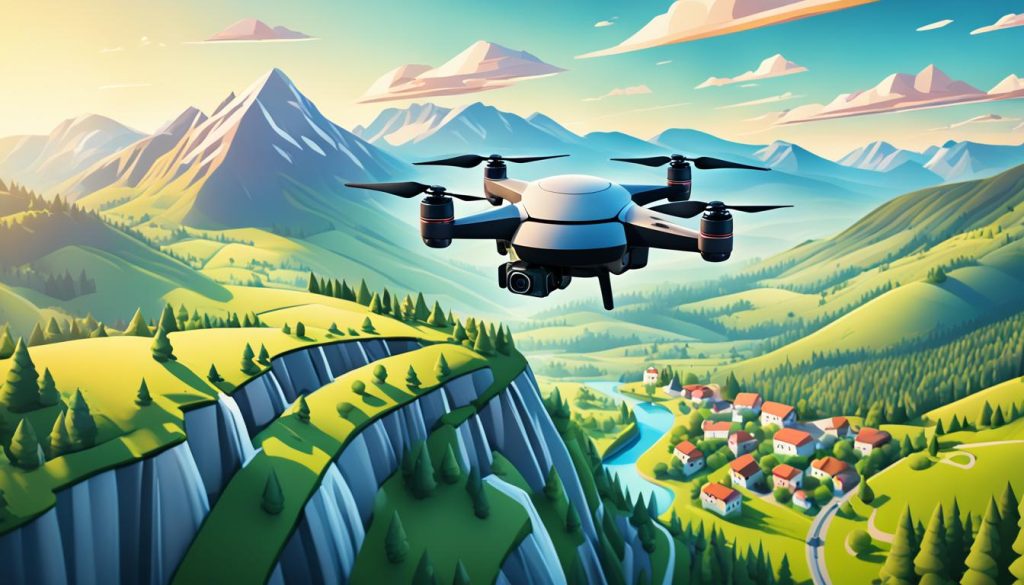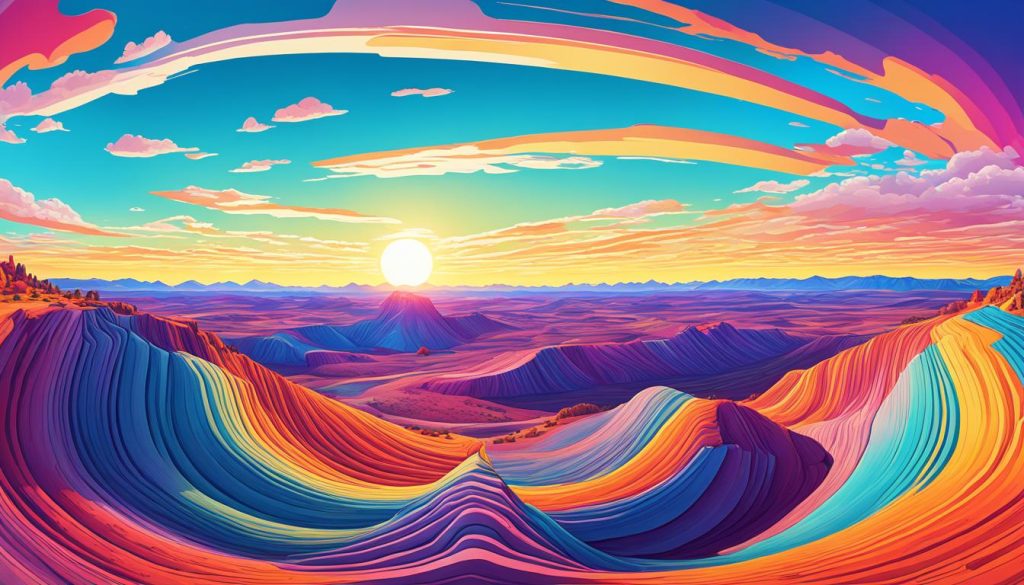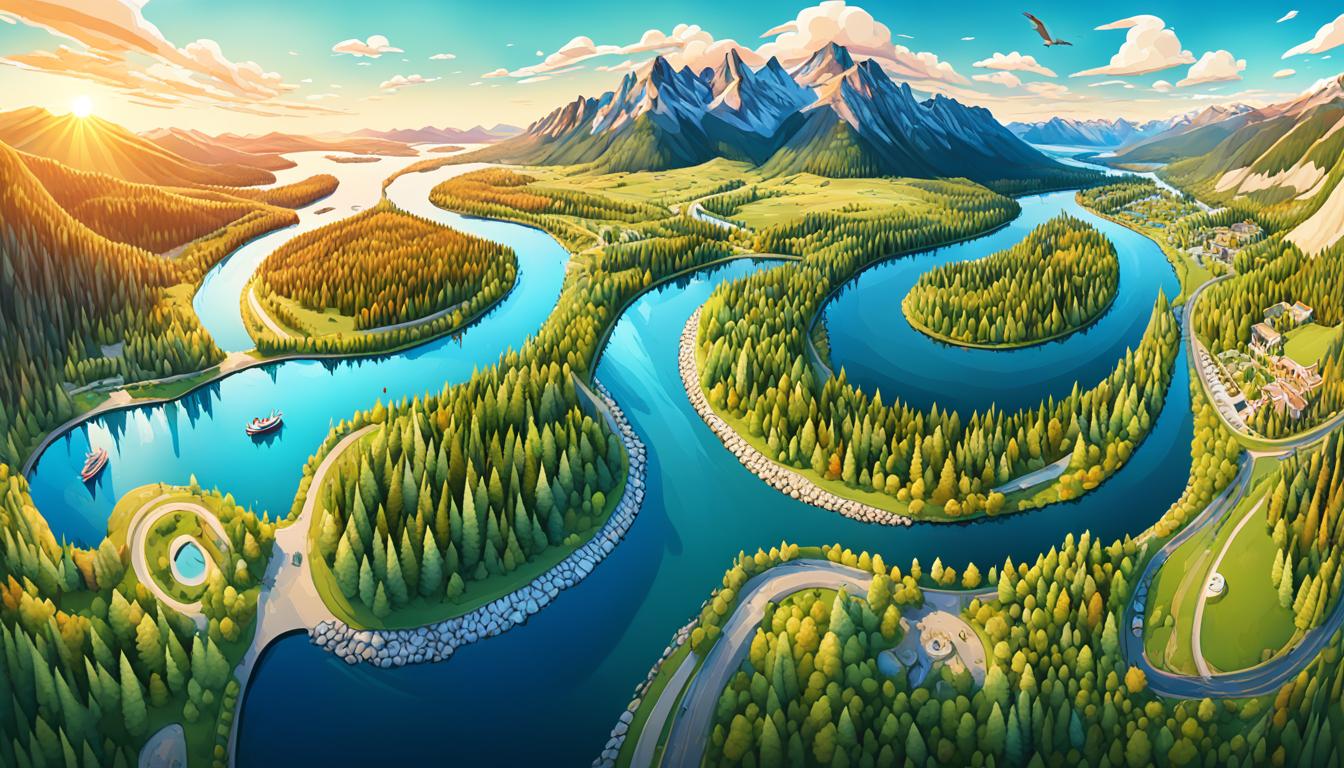You can make stunning aerial landscapes by combining drone images with AI panorama stitching. This tech uses artificial intelligence to improve traditional panorama methods. It lets you easily create 360-degree views that are truly breathtaking.
AI-powered image stitching changes the game for aerial photography. It uses smart algorithms to merge photos, fix distortions, and adjust light levels. This means you get perfect panoramas that show the beauty of the world from above.
Drone mapping and photogrammetry get a big boost from AI panorama stitching. This tech helps create detailed 3D models and maps of large areas. Whether you’re a pro or just taking photos for fun, learning AI panorama stitching can take your aerial photos to the next level.
Understanding AI Panorama Stitching Technology
AI panorama stitching changes how we make amazing aerial views. This new tech uses computer vision to join many images into one big panorama. Let’s see how AI makes old methods better and changes how we take aerial photos.
What is AI panorama stitching?
AI panorama stitching combines images with smart algorithms. It looks at each photo and puts them together into one big view. It makes sure photos line up right, fixes light issues, and removes unwanted parts. This makes the final image look amazing and detailed.
AI enhancements to traditional panorama techniques
Old panorama ways can’t handle complex scenes well. But AI stitching is different. It works fast and accurately, even with tough scenes and changing lights. This makes the photos better and tells stories in a more engaging way.
Benefits for aerial photography
AI stitching has many benefits for taking aerial photos:
- Creates ultra-high-resolution images (up to 10000 x 5000 pixels or more)
- Processes complex scenes with varying lighting quickly
- Improves accuracy in alignment and exposure blending
- Enables greater detail and immersion in final panoramas
- Enhances visual storytelling capabilities for photographers
With AI panorama stitching, you can make amazing aerial views that go beyond what old photography can do. This tech opens up new ways to capture and share stunning views from above.
Essential Equipment for Aerial Panorama Photography
To capture stunning aerial panoramas, you need the right gear. A high-quality drone with manual camera controls is key for drone mapping and landscape photography. Make sure your drone has enough flight time to get all the shots you need for your panorama.
The camera on your drone is very important. Choose one with a narrower-angle lens for more natural-looking panoramic shots. Stay away from lenses wider than 35mm to avoid distortion in your final image.
Neutral density (ND) filters are a must for bright conditions. They help keep your panorama’s image quality consistent, even when the light changes.
A reliable remote controller with a built-in screen or smartphone mount is crucial. It lets you frame your shots right and keep an eye on your drone’s position while taking panoramic images.
| Equipment | Purpose | Importance |
|---|---|---|
| High-quality drone | Stable flight for image capture | Essential |
| Camera with manual controls | Consistent exposure across shots | Critical |
| Narrower-angle lens | Natural-looking panoramas | Highly recommended |
| ND filters | Exposure control in bright light | Very important |
| Remote controller with screen | Accurate framing and monitoring | Necessary |
Preparing Your Drone for Panoramic Shots
Getting ready for aerial photography takes careful planning and setup. Your drone’s setup is key to getting amazing panoramas. Let’s look at the main steps to get your drone ready for stunning shots.
Selecting the Perfect Flight Altitude
The height you fly at changes how clear your photos are and what you can see. Flying too low might mean missing out on the big picture. Going too high could make things blurry. Try different heights to find the best view. Start at 100 feet and go up to 400 feet, seeing how the view changes.
Optimizing Camera Settings
For consistent shots, use manual mode. A fast shutter speed, like 1/1000th of a second, helps avoid blur. Keep your ISO low for clear images. Adjust the aperture for depth of field, usually f/5.6 to f/8 for drone shots.
Mapping Out Your Flight Path
Plan your flight path for smooth stitching. Aim for at least 20% overlap between photos. Fly in a grid pattern, keeping your speed and height steady. Think about wind direction and lighting. The golden hour gives warm, soft light great for dramatic scenes. Cloudy days are perfect for computational photography.
| Altitude | Coverage Area | Detail Level |
|---|---|---|
| 100 feet | Small | High |
| 250 feet | Medium | Moderate |
| 400 feet | Large | Low |
Practice makes perfect. Try different heights and settings to find unique views. With these tips, you’re set to take amazing panoramic shots from above.
Capturing Raw Images for AI Panorama Stitching
To make amazing aerial panoramas, start by taking high-quality raw images. Set your drone camera to manual mode. This makes sure all photos have the same settings, which is key for stitching without problems.
Always shoot in RAW format for more editing options. RAW files keep more image data, making it easier to adjust during the stitching process. Use a grid on your camera to help frame each shot perfectly.

Take more photos than you think you’ll need for the best results. This gives the AI stitching software lots of data to work with. Using bracketed exposures can also help make HDR panoramas, especially in tough lighting.
| Setting | Recommendation | Purpose |
|---|---|---|
| Camera Mode | Manual | Consistent exposure |
| File Format | RAW | Maximum editing flexibility |
| Overlay | Grid | Precise framing |
| Shooting Technique | Bracketing | HDR potential |
Watch out for moving objects like cars or people in your scene. They can mess up the stitching. Try to take your photos when the area is calm for the best panorama.
Use AI Panorama Stitching to Create Breathtaking Aerial Landscapes
AI panorama stitching takes aerial photography to new heights. It combines photogrammetry and computational photography for stunning wide-angle views. Let’s see how AI-powered software can help create breathtaking aerial landscapes.
Step-by-step guide to using AI stitching software
Begin by adding your photos to AI stitching software like Skybox AI or Luminar Neo. These tools use smart algorithms to blend your photos. Just select your images, pick a stitching mode, and let the AI do the rest.
Adjusting overlap and alignment settings
For smooth blending, adjust the overlap settings. Try for 20-30% overlap between images. This gives the AI enough data for accurate matching. Then, fine-tune alignment settings to fix any issues. Most software lets you make manual changes if needed.
Handling exposure differences between images
Aerial shots often have different light conditions. Use AI tools to balance exposure and color. These features look at each image and make corrections for a uniform panorama. Try different stitching algorithms to find the best look for your landscape.
Mastering these techniques will help you make panoramas that show off aerial beauty. The mix of AI technology and your creative eye will lead to amazing landscape photos.
Post-Processing Techniques for Enhanced Panoramas
After stitching your aerial panoramas, post-processing is key to elevate your visual storytelling. AI-powered tools offer exciting possibilities for landscape photography enthusiasts. These advanced techniques can transform your wide-angle shots into breathtaking masterpieces.
Start by using AI-driven software to automatically adjust contrast, clarity, and color. This step enhances the overall look of your panorama while maintaining a natural appearance. Experiment with Look-Up Tables (LUTs) to quickly apply different styles to your image, creating mood and atmosphere.

Content-aware tools are game-changers in landscape photography. They allow you to add atmospheric effects like fog or sun rays, bringing depth and drama to your panoramas. For fine-tuning, use AI-enhanced sharpening and noise reduction to bring out crisp details without introducing artifacts.
Consider cropping your panorama to improve composition. This technique can help focus viewer attention on the most impactful elements of your landscape while preserving the wide-aspect ratio that makes panoramas so captivating.
| Post-Processing Technique | Benefits | AI Advantage |
|---|---|---|
| Automatic Adjustments | Balanced exposure and color | Intelligent scene analysis |
| LUT Application | Quick style changes | Advanced color grading |
| Atmospheric Effects | Enhanced mood and depth | Realistic environment simulation |
| Detail Enhancement | Crisp, clear images | Selective sharpening without noise |
| Smart Cropping | Improved composition | Content-aware framing suggestions |
Overcoming Common Challenges in AI Panorama Stitching
AI panorama stitching opens up new possibilities in aerial photography. But, it also has its challenges. Let’s look at some common issues and how to fix them with advanced computer vision.
Dealing with Moving Objects
Moving objects can cause ghosting or blur in your panoramas. AI tools for removing objects help solve this. These smart algorithms can spot and remove things like cars, people, or animals moving between shots.
Correcting Lens Distortion and Perspective Issues
Lens distortion can make your images look warped, especially at the edges. Modern stitching software uses AI to fix these problems. It ensures your panorama looks natural and distortion-free all the way across.
Addressing Color Inconsistencies
Changes in light can cause color differences between images. AI tools for matching colors look at and adjust each frame for a smooth blend. For tricky areas like water or skies, AI-powered sky replacement can make everything perfect.
| Challenge | AI Solution | Benefit |
|---|---|---|
| Moving Objects | Object Removal Tools | Clean, Ghost-free Images |
| Lens Distortion | AI Lens Correction | Natural-looking Panoramas |
| Color Inconsistencies | AI Color Matching | Seamless Color Blending |
Using these AI solutions helps you beat the usual panorama stitching problems. The end result? Stunning aerial views that grab attention and highlight your photography talent.
Creative Applications of AI-Stitched Aerial Panoramas
AI-stitched aerial panoramas open up a world of creative possibilities. They let you craft immersive experiences that captivate audiences. These images showcase landscapes in new ways.
Virtual tours are a great use for AI-stitched panoramas. By combining shots, you can make 360-degree views of cities, parks, or historic sites. These tours let viewers explore places from home, offering a unique view that ground-level photos can’t match.
Drone mapping also benefits from AI panorama stitching. You can make detailed, high-resolution maps of large areas by combining aerial images. These maps are key for urban planning, agriculture, and environmental monitoring.
Real estate and tourism can use AI-stitched panoramas for marketing. They can show properties or destinations with stunning aerial views. These visuals can boost interest and engagement from potential buyers or visitors.
| Application | Benefits | Industries |
|---|---|---|
| Virtual Tours | Immersive exploration, remote access | Tourism, Education, Real Estate |
| Drone Mapping | Detailed terrain analysis, large area coverage | Agriculture, Urban Planning, Environmental Studies |
| Marketing Materials | Stunning visuals, increased engagement | Real Estate, Tourism, Hospitality |
| VR Experiences | Interactive environments, enhanced immersion | Gaming, Entertainment, Training |
Try combining multiple panoramas for multi-layered compositions or time-lapse effects. This can show changes in landscapes over time. Or, create unique artistic pieces that blend different perspectives into one captivating image.
Best Practices for Sharing and Displaying Your Panoramas
Sharing your stunning aerial panoramas is the final step in your visual storytelling journey. Let’s explore how to optimize your work for various platforms. This will create engaging experiences for your audience.
Optimizing file sizes for web and print
When preparing your panoramas for the web, balance quality and file size. Use compression techniques to reduce file sizes. This way, you keep the high-resolution imaging that makes your work stand out. Create multiple versions for different devices to ensure smooth loading across platforms.
Choosing the right platforms for showcasing your work
Select platforms that cater to panoramic photography. Sites like 500px and Flickr offer dedicated spaces for panoramas. These platforms often support high-resolution imaging, preserving the details of your aerial landscapes.
| Platform | Features | Audience |
|---|---|---|
| 500px | High-quality display, licensing options | Professional photographers |
| Flickr | Large community, groups for panoramas | Mix of amateur and pro photographers |
| Personal Website | Full control over presentation | Dedicated followers, potential clients |
Creating interactive panorama experiences
Elevate your visual storytelling by creating interactive experiences. Use tools like Kuula or Google Street View to allow viewers to explore your panoramas. These immersive displays bring your aerial landscapes to life, giving viewers a sense of being there.
Consider printing large-format panoramas for exhibitions or art installations. This physical display option can create a powerful impact. It showcases the true scale and detail of your aerial photography work.
Conclusion
AI panorama stitching has changed aerial photography for the better. It lets you create stunning landscapes with ease. By using artificial intelligence, you can merge images together perfectly, making panoramic views from above look amazing.
This new tech mixes art with smart algorithms. It helps you solve old problems in making panoramas. Now, you can handle different exposures and fix lens distortion easily, making your aerial photos better.
Trying out AI panorama stitching in aerial photography is exciting. Remember, getting better takes practice and trying new things. Every flight and photo session is a chance to improve. With AI getting better, the future of aerial photography is bright. It promises even more ways to capture and share the beauty of our world from above.






